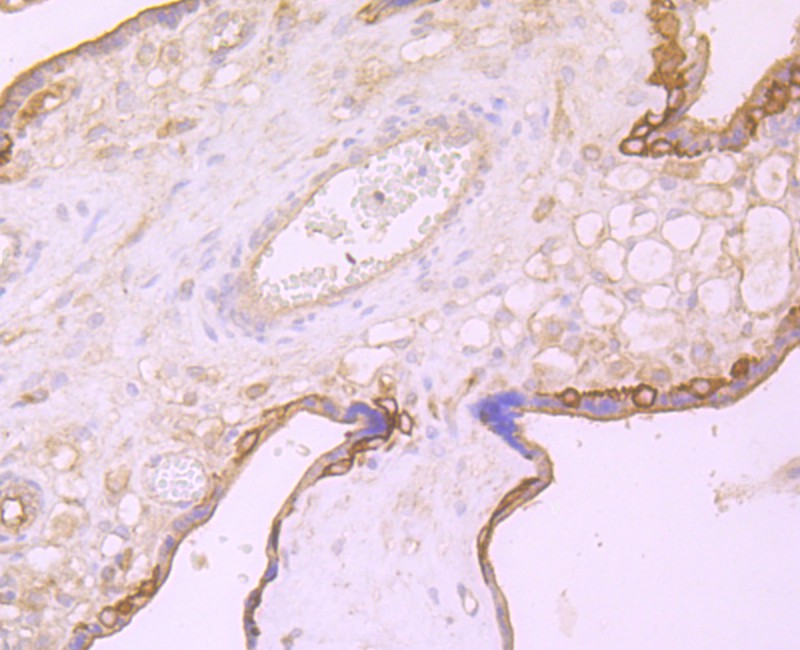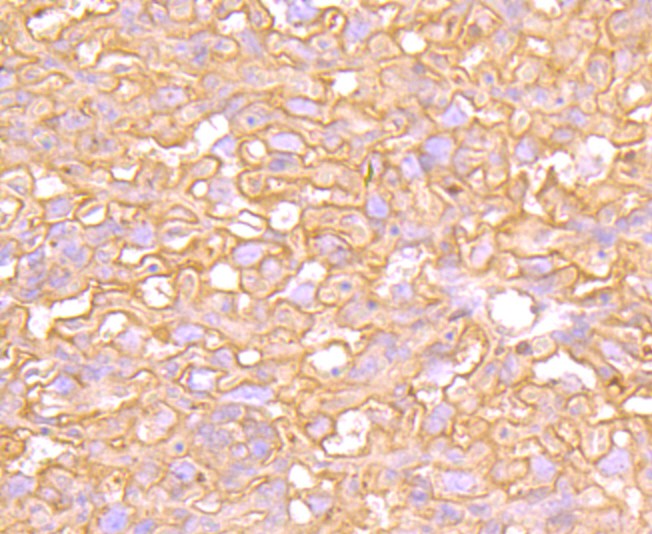EGFR Mouse Monoclonal Antibody [B6-E5-D9]

cat.: EM1701-22
| Product Type: | Mouse monoclonal IgG2a, primary antibodies |
|---|---|
| Species reactivity: | Human, Mouse, Rat |
| Applications: | WB, IHC-P, IF-Cell, FC |
| Clonality: | Monoclonal |
| Clone number: | B6-E5-D9 |
| Form: | Liquid |
| Storage condition: | Store at +4℃ after thawing. Aliquot store at -20℃ or -80℃. Avoid repeated freeze / thaw cycles. |
| Storage buffer: | 1*PBS (pH7.4), 0.2% BSA, 50% Glycerol. Preservative: 0.05% Sodium Azide. |
| Concentration: | 2ug/ul |
| Purification: | Protein G affinity purified. |
| Molecular weight: | Predicted band size: 134 kDa |
| Isotype: | IgG2a |
| Immunogen: | Recombinant protein within human EGFR aa 900-1100. |
| Positive control: | A431 cell lysate, U-87 MG cell lysate, A549 cell lysate, LOVO, SW480, human tonsil tissue, human placenta tissue, mouse placenta tissue, human stomach cancer tissue, A431. |
| Subcellular location: | Cell membrane, Nucleus, cytoplasm. |
| Recommended Dilutions:
WB IF-Cell IHC-P FC |
1:5,000-1:10,000 1:100-1:500 1:50-1:200 1:50-1:100 |
| Uniprot #: | SwissProt: P00533 Human | Q01279 Mouse |
| Alternative names: | Avian erythroblastic leukemia viral (v erb b) oncogene homolog Cell growth inhibiting protein 40 Cell proliferation inducing protein 61 EGF R EGFR EGFR_HUMAN Epidermal growth factor receptor (avian erythroblastic leukemia viral (v erb b) oncogene homolog) Epidermal growth factor receptor (erythroblastic leukemia viral (v erb b) oncogene homolog avian) Epidermal growth factor receptor erb-b2 receptor tyrosine kinase 1 ERBB ERBB1 Errp HER1 mENA NISBD2 Oncogen ERBB PIG61 Proto-oncogene c-ErbB-1 Receptor tyrosine protein kinase ErbB 1 Receptor tyrosine-protein kinase ErbB-1 SA7 Species antigen 7 Urogastrone v-erb-b Avian erythroblastic leukemia viral oncogen homolog wa2 Wa5 |
Images

|
Fig1:
Western blot analysis of EGFR on different lysates with Mouse anti-EGFR antibody (EM1701-22) at 1/1,000 dilution. Lane 1: A431 cell lysate Lane 2: U-87 MG cell lysate Lane 3: A549 cell lysate Lysates/proteins at 20 µg/Lane. Predicted band size: 134 kDa Observed band size: 160 kDa Exposure time: Lane 1: 5 seconds; Lane 2-3: 43 seconds; ECL: K1801; 4-20% SDS-PAGE gel. Proteins were transferred to a PVDF membrane and blocked with 5% NFDM/TBST for 1 hour at room temperature. The primary antibody (EM1701-22) at 1/1,000 dilution was used in 5% NFDM/TBST at 4℃ overnight. Goat Anti-Mouse IgG - HRP Secondary Antibody (HA1006) at 1/50,000 dilution was used for 1 hour at room temperature. |

|
Fig2: ICC staining EGFR (green) in LOVO cells. The nuclear counter stain is DAPI (blue). Cells were fixed in paraformaldehyde, permeabilised with 0.25% Triton X100/PBS. |

|
Fig3: ICC staining EGFR (green) in SW480 cells. The nuclear counter stain is DAPI (blue). Cells were fixed in paraformaldehyde, permeabilised with 0.25% Triton X100/PBS. |

|
Fig4: Immunohistochemical analysis of paraffin-embedded human tonsil tissue using anti-EGFR antibody. Counter stained with hematoxylin. |

|
Fig5: Immunohistochemical analysis of paraffin-embedded human placenta tissue using anti-EGFR antibody. Counter stained with hematoxylin. |

|
Fig6: Immunohistochemical analysis of paraffin-embedded mouse placenta tissue using anti-EGFR antibody. Counter stained with hematoxylin. |

|
Fig7: Immunohistochemical analysis of paraffin-embedded human stomach cancer tissue using anti-EGFR antibody. Counter stained with hematoxylin. |

|
Fig8: Flow cytometric analysis of A431 cells with EGFR antibody at 1/100 dilution (red) compared with an unlabelled control (cells without incubation with primary antibody; black). Alexa Fluor 488-conjugated Goat anti mouse IgG was used as the secondary antibody. |
Note: All products are “FOR RESEARCH USE ONLY AND ARE NOT INTENDED FOR DIAGNOSTIC OR THERAPEUTIC USE”.